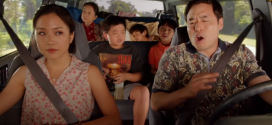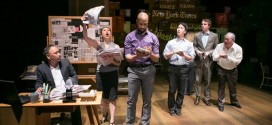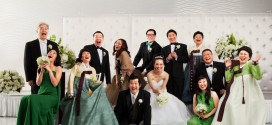By Yi Chen
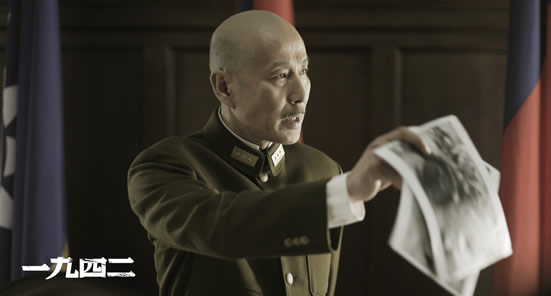
I have been a big fan of Chinese director Feng Xiaogang’s films since his 1997 comedy Dream Factory. His films were part of a family tradition: around almost every Chinese New Year my family would go to see his Hesui Pian, or Lunar New Year blockbusters. Romantic comedies made him famous in China, but Feng Xiaogang is no stranger to epic historical films. His Tangshan earthquake epic Aftershock (2010) was the first to gross over $100 million in China’s domestic box office.
Now his latest work, Back to 1942, certainly epic in scope, is on track to break box office records in China. It has been also lighting up screens in U.S. cities, including Gaithersburg in suburban Maryland, and is available for download. It’s a searing look at the deadly drought in 1942 that devastated central China’s Henan province during the war against Japan, and it features a mix of top Chinese and American actors.
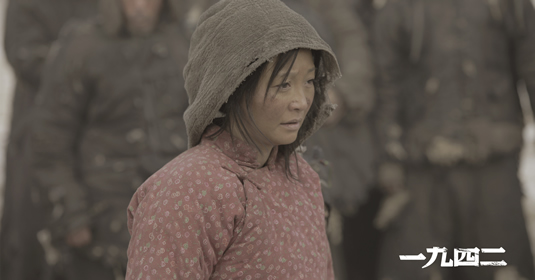
It has taken a long time for Feng Xiaogang to get the story in theaters. He first met author Liu Zhengyun, whose 1993 memoir Remembering 1942 is the basis for the film. They tried to adapt the story into movie form for years, but kept bumping up against creative and logistical barriers. The fact that the director felt strongly enough about the material to keep at it intensified my desire to see the film and discover what made him so dedicated.
The film starts with a chaotic scene at a wealthy landlord Fan’s (Zhang Guoli) home in Henan province. Starving and desperate villagers arrive with sickles and torches in search of food, as Fan holds the last stocks of grains in the village. A banquet for the villagers ends in violence and flames. Zhang carries the character’s intricate swirl of emotions—anger, sadness, and fear—with a composed performance and delivers a sense of helplessness as Fan watches his wealth vanish in front of his eyes. Even this most fortunate family ends up seeking refuge on a long journey to Shaanxi province, with a donkey cart carrying a young daughter, a pregnant daughter-in-law and an elderly mother.
While refugees are munching on tree bark in Generalissimo Chiang Kai-shek’s (Chen Daoming) provisional capital Chungking, fine cuisine and imported wine are served at parties for diplomats, military officers and bureaucrats. Legendary TIME magazine journalist Theodore White’s (Adrien Brody) first appearance in the film is at one of these parties. Author Liu Zhengyun came across two of White’s books,—“In Search of History: A Personal Adventure” and “Thunder Out of China,” while researching “Remembering 1942.” White’s books detail his first-hand observations of the 1942 Henan famine.
White’s character is the most developed one in the film. Brody shows White driven by the desire to uncover the truth behind the famine. Brody, whose work in The Pianist as a victim of the Nazis during WWII won him an Academy Award at age 29, turns in a fully authentic performance, making White’s deep concern over the millions of Chinese refugees palpable. America’s Tim Robbins also turns up in the film as a cynical and pragmatic Catholic priest, Father Thomas Megan.
With a $35 million budget, Back to 1942 delivers grand visual spectacle, intercut with quieter, intimate moments in counterpoint. The efforts of cinematographer Lü Yue (Red Cliff), composer Zhao Jiping (Red Sorghum), and costume designer Yip Kam-tim (Crouching Tiger, Hidden Dragon) are seamless. The stark and gloomy look of the refuges’ scenes contrast dramatically with the parallel storyline depicting the corruption of the ruling Nationalist Government, which is richer in color and cinematically feels like a completely different world.
The book doesn’t have a conventional plot or central characters, as the use of multiple characters allows different perspectives of the famine, and that makes it a challenge for a film adaptation. I did not leave the theater feeling a strong emotional connection to any of the characters. I was left thinking about the history and wanting to find out more.
In Shanghai where I grew up, there are many places that remind me of Japanese occupation during WWII, but like many people, I never knew about the 1942 famine that left more than three million dead. The film has made me think. I want to ask my 90-year old grandmother her memory of the year 1942.
In Mandarin, English and Japanese with English subtitles. Total running time: 2 hr 26 min. “Back to 1942” has played at AMC Loews Rio Cinemas 18, 9811 Washingtonian Boulevard, Gaithersburg, MD. It is available for download, often free, at www.yidio.com or http://moivemaza.wordpress.com and other sites.
 Asian Fortune Your source for all things Asian American
Asian Fortune Your source for all things Asian American

